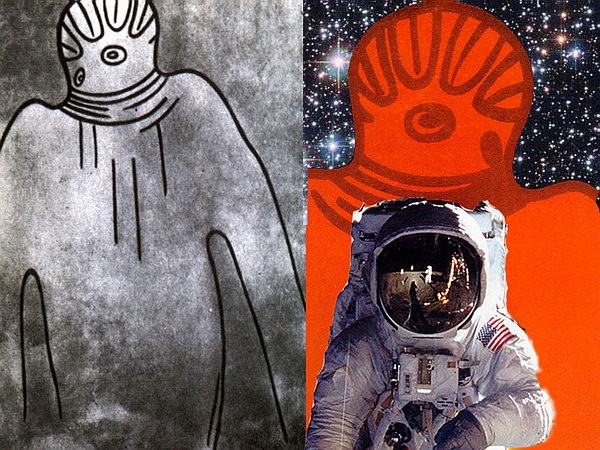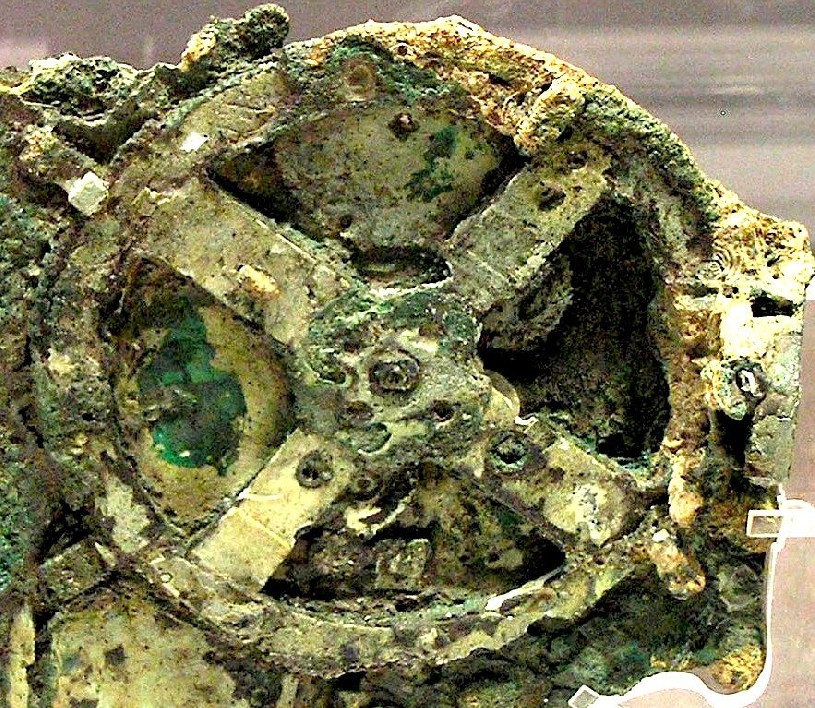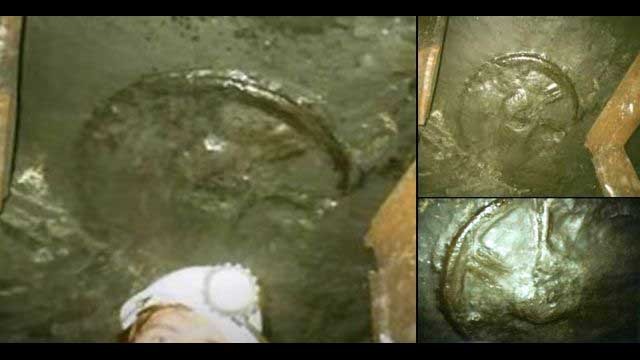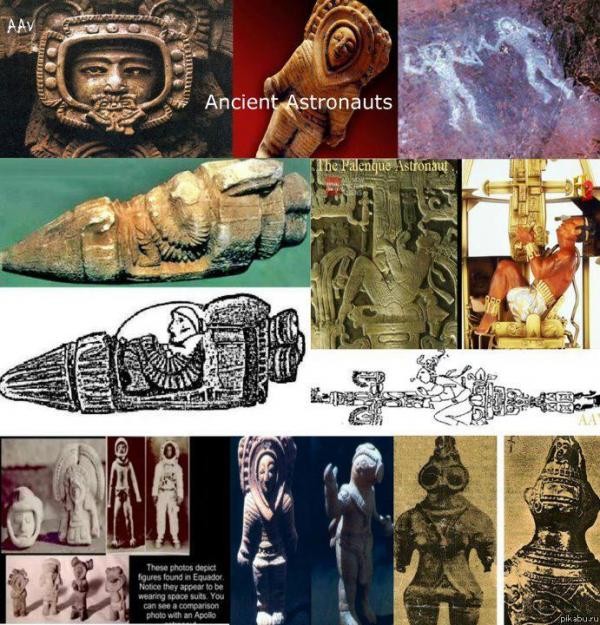Memories of the Future" is the most famous of the documentaries about the mysteries of the origin of mankind and the origin of civilizations. The film is based on the book by Erich von Daniken "Chariots of the Gods", which, like the film, became a bestseller all over the world.
Please note this is a comparison between Version 2 by Oleg Дмитриевич Verstogov and Version 4 by Oleg Дмитриевич Verstogov.
The flag and banner of the history of the Earth. The Book of the Chariots of the Gods.. The real history of the Earth.
- diezelsun
- diezel sun
- творческий стиль уфолизм
- художник-уфолист

Its author, German researcher Erich von Deniken, shocked the imagination of the Soviet audience with his bold and audacious hypothesis — in ancient times there were cosmonauts of antiquity, paleoastronauts on Earth. A little historical background. The real history of the Earth is largely unknown. Why did the ancient peoples depict their Gods in some kind of spacesuits? At least they look a lot like astronauts. Where did they get such knowledge? Normally, it is not even known who built stone structures around the world... There are certain assumptions, but they still take doubts. How, for example, to explain the ancient machine processing of stone?
-
How, for example, to explain the ancient machine processing of stone? When did dinosaurs actually become extinct? Was the territory of present-day Russia inhabited during the "ice age"? How many ancient civilizations existed on planet Earth and what was the level of their technological development? Is it true that the gigantic expanses of the north of the Russian Plain, the Urals, Siberia and the Far East remained uninhabited until Modern times? What traces of ancient civilizations have been found on the territory of present-day Russia? Why do facts say one thing and scientists say something completely different? How many more irrefutable proofs of the existence of the most ancient highly developed civilizations have been found in the world? This film contains only some of the most striking facts that contradict the official history prevailing in the scientific world today. Famous Russian scientists, writers and travelers Andrei Burovsky, Georgy Sidorov and Vitaly Sundakov will share their thoughts on what the history of mankind really was.
Mysterious historical finds.
Every inhabitant of the Earth who is lucky enough to study at school gets about the same set of ideas about the past of our planet and its inhabitants. It is believed that life originated here about 3 billion years ago. It developed, became more complicated — and then 2.5 million years ago, somewhere in Africa, the first person appeared who walked firmly on two legs, and took a club in his hands for protection (still uncertainly).
For 2 million years he lived in trees and in inaccessible mountain caves. I was engaged in gathering — I was looking for edible berries, nuts, fruits of angiosperms. He extracted sea and river mollusks in shallow water, split them and ate them raw. I picked up fresh carrion — the remains of someone else's prey.
Later, about 300 thousand years ago, he mastered the technology of joint hunting using the simplest weapons. Lacking sharp fangs and claws, our distant ancestor began to use angular pieces of rock. And over time, he even learned how to make stone axes and spears out of them. Primitive people gathered in hunting brigades — and together they hunted large and small animals. Then they divided the loot and lived in small tribes, defending themselves from wild animals and hostile tribes. So human society finally appeared. Gradually, the number of primitive people increased so much that they began to disperse all over the planet, populating Europe, Asia, both Americas and Australia. A familiar picture, isn't it?..
Moreover, when we say "Europe", in this case we mean only the southern part of Western Europe. And the entire North of the Eurasian continent at that time, according to scientists, was occupied by a multi-kilometer glacier that melted only 15-10 thousand years ago.
And here we are faced with the first serious contradiction. In the second half of the twentieth century, several high-profile archaeological discoveries were made on the territory of Russia, which cast doubt on the theory of glaciation. When digging a pit in the Vladimir region, builders accidentally discovered the burial of ancient people. Later it will turn out to be the world-famous Sungir archaeological monument, whose age, according to some estimates, reaches up to 28,000 years. The ancient people who lived in Sungiri were no different from us, their distant descendants. They were tall (up to 187 cm), white skin and the same brain volume as ours. They had a developed civilization, which had a high level of technology for that time. They knew how to straighten the mammoth bone and sewed themselves fashionable sheepskin coats, decorating them with rhinestones (multicolored bone beads). Agree, this is quite strange for primitive people who came down from the trees not so long ago.
Another discovery struck the scientific world even more. In Western Siberia, in the Krasnoyarsk Territory, near the city of Achinsk, on lands that have always been considered "not historical", Soviet archaeologist Vitaly Larichev discovered a strange object that looks like a rod with a spiral pattern. Upon careful examination, this pattern, consisting of 1065 small icons, turned out to be a lunar-solar calendar for several years. Something like a modern souvenir calendar, which we put on our table. Only for 3-4 years at once. The nature of the calendar gave grounds to assert that its compilers had serious knowledge in the field of astronomy and could predict lunar and solar eclipses. This find was dubbed the "Achinsk rod". Its age is about 18,000 years. This is the oldest calendar on earth. And besides, quite accurate.
As you probably know, Siberia has a very harsh climate even today, when there is no glacier on the Eurasian continent. The thermometer drops to minus 50 degrees in winter. What should have been there when the multi-kilometer freezer of the Wurm glacier lay literally several hundred kilometers away, and the entire territory was covered with permafrost?.. Is civilized life and... fundamental science possible in such harsh conditions?.. In the same Krasnoyarsk Territory, in the Denisova cave, the remains of a girl who lived 75 thousand years ago were found. Now the term "Denisov man" has appeared in science. Archaeologists suggest that since the period of 40,000 years before the new era, the "Denisov man" inhabited vast territories of Western Siberia. Let us recall once again that modern historians consider Siberia to be an “unhistorical land”, there allegedly never were any centers of civilization. All foci are usually found only in the Middle East and Western Europe. But here's the bad luck - it turns out that the Siberian archaeological finds are several times older than their counterparts in other parts of the world.
It turns out that people in Siberia have lived since time immemorial. Could they at the same time not create culture, science and at least the simplest statehood?..
And the discovery made beyond the Arctic Circle, in Yakutia, at the mouth of the Berelekh River, does not fit into the theory of glaciation at all. There was found a parking lot of primitive people who — ATTENTION! — tamed mammoths! Yes, yes, they tamed mammoths and used them as pets. As you understand, mammoths are very big animals, bigger than elephants and much larger than cows. They need to eat a lot in order not to lose weight. Therefore, they simply cannot live in permafrost territories. They need meadows overgrown with lush grass and shrubs… What conclusion can be drawn from this? Only one: in ancient times in the north of Siberia there was quite a mild climate. There was a generous sun, warm winds blew and vegetation was rampant.
By the way, the mammoths' habitation beyond the current Arctic Circle has long been no secret for scientists and for ordinary residents of these latitudes - the northern peoples, as well as Russian research scientists and workers. The fact is that in the north of Russia, in the permafrost, mammoth tusks have always been found and are found today in an amount close to industrial.
From them, the northern peoples have since ancient times made household items (for example, bone knives and spearheads), as well as works of art. Numerous skeletons and even mammoth mummies are on display in the historical museums of almost every major Russian city.
Most of all, today's scientists are struck by the phenomenon of the so-called polygonal masonry. When large stone blocks are not standardized in size, but are perfectly fitted to each other according to the peculiarities of their shape, including the smallest bulges and slopes. Thanks to this fit, the blocks fit one on top of the other, like puzzles, and hold perfectly without any solution.
By the way, the blocks of the Egyptian pyramids on the Giza plateau are laid in the same way. Researchers are finding something similar in Russia. An example of this is the recent discovery in the Mountain Shoria made by the expedition of Georgy Sidorov. Having tried to imagine with what tools it was possible to lay the stones in this way, Russian researchers have put forward several hypotheses, each of which assumes the highest level of technological progress. Another hypothesis suggests a currently unknown method of chemical or thermal softening of the stone to the state of plasticine. This alleged technology was conditionally called "plasticine".
The participants of Andrey Sklyarov's expedition traveled all over the world and in many places on the oldest buildings, the age of which is hidden by the mist of millennia, found traces of high-tech machine processing. Including traces of circular saws and grinding on a lathe. Here is an example from Lebanon, from the ruins of the ancient city of Baalbek. Recently, scientists around the world have been thinking more and more often that it's time to reconsider our ideas about the development of human civilization.
In Mexico, the Museum of Local Lore of the city of Icca has a huge collection of stones engraved with scenes from the life of ancient people who lived side by side with dinosaurs. They were collected in the middle of the 20th century by a local Spanish surgeon and aristocrat Javier Cobrero. Fifteen hundred of the most complex drawings are applied to water-rolled pieces of granite. It is difficult to make such things even with the help of modern devices. And in the collection of Dr. Kobrero there are more than one and a half thousand such stones. The most amazing thing is that some of the stones depict ancient animals known only to specialists. How could the Indians, who are not familiar with paleontology, know the features of the structure of extinct animals?..
Researchers suggest that the Ikki stones are a kind of library, which is designed to store a variety of knowledge and convey it to posterity. Therefore, the collection of Dr. Kobrero is called litoteca. In addition to dinosaurs, the stones depict scenes of medical procedures, including such complex ones as abdominal operations and skull trepanation. Even devices for deep anesthesia and an anesthesiologist are visible! Other stones depict astronomy classes and even stylized flying machines.
Photos of historical artifacts.




















The image of God created by the artist. Such a Deity was depicted in one of the Mayan temples.


References

Zhukov Andrey
IKI STONES — THE MESSAGE OF AN IMPOSSIBLE CIVILIZATION
 Encyclopedia
Encyclopedia
